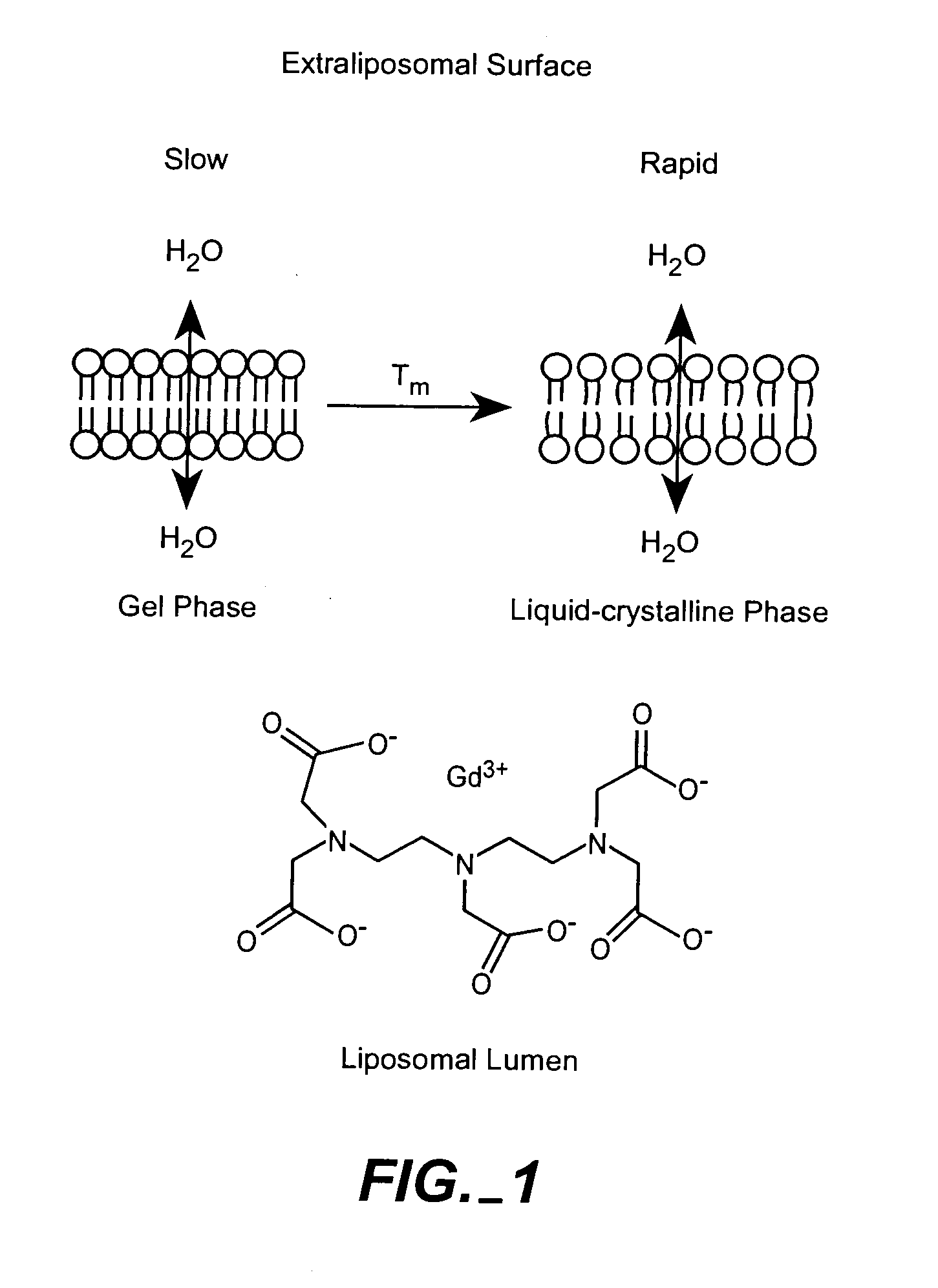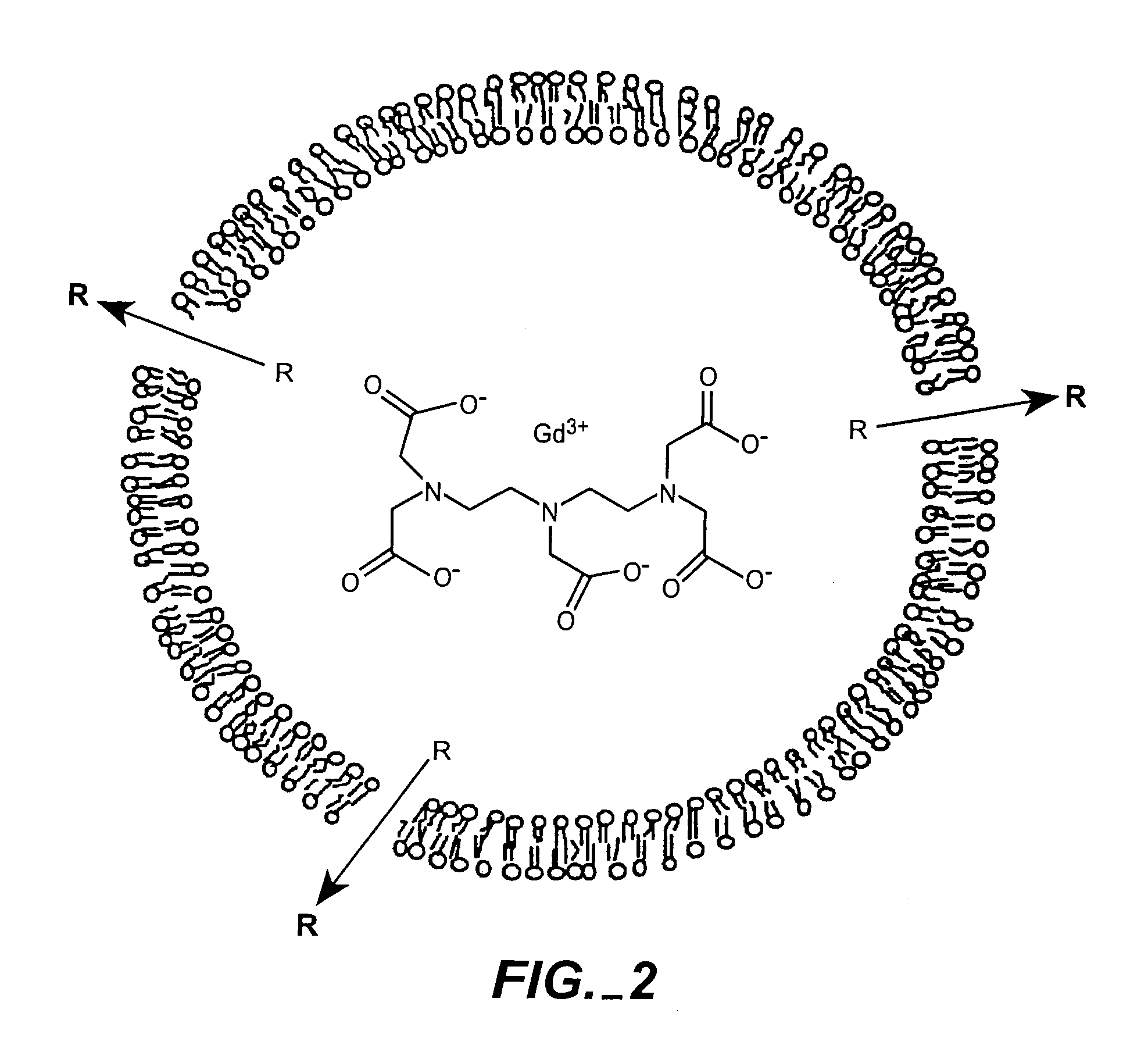Remote detection of substance delivery to cells
a technology of endocytosis and remote detection, which is applied in the field of endocytosis sensitive probe development, can solve the problems of poor encapsulation efficiency of paramagnetic ions, early results were hindered, liposome instability, etc., and achieve the effects of increasing the effect of proton relaxivity, increasing the effect of fluorescence, and low effect on proton relaxivity
- Summary
- Abstract
- Description
- Claims
- Application Information
AI Technical Summary
Benefits of technology
Problems solved by technology
Method used
Image
Examples
example 1
Preparation of Caged Liposomal Carriers
[0061]Multiple formulations of low permeability Gd-liposomes were prepared. Multiple liposome formulations of Gd-chelates have been prepared. These liposomes were composed of distearoylphosphatidylcholine (DSPC), cholesterol, and N-poly(ethylene glycol)-distearoylphosphatidylethanolamine (PEG2000-DSPE) or mixtures of DSPC, dipalmitoylphosphatidylcholine (DPPC), and cholesterol (phospholipid:cholesterol (3:2). DPPC was added at small molar ratios to increase the rate of degradation upon reaching the endosomes. However, DPPC does have a lower phase transition than DSPC, and will likely increase the rate of diffusion of water molecules across the liposomal membrane. It remains to be seen to what extent this modification will have on the change in relaxivity upon encapsulation. This is currently being studied and will be compared to other liposomes of varying lipid composition in attempt to optimize the rate of lipid degradation and water permeabil...
example 2
Synthesis of bis-carboxymethyl-PEG600-mono(N,N-dioctadecyl)amide (DSA-PEG-COOH)
[0070]3.039 g of bis-carboxymethyl-poly(ethylene glycol) (M.w. 600; Aldrich p / n 40, 703-8) were dissolved in 20 mL of chloroform, and stirred with 250 mg of DCC at room temperature for 1 hour. The precipitated urea was filtered out using glass fiber filter, the filtrate was cooled down in an ice bath, mixed with 1 mL of anhydrous triethylamine, and 520 mg of dioctadecylamine (Fluka p / n 42358). The reaction mixture was brought to 40-45° C. with stirring until all amine was dissolved, overlaid with argon, and stirred at room temperature overnight. The precipitated additional amount of DCU was filtered out, the filtrate was diluted with 20 mL of chloroform and washed consequently with 100 mL of water (3 times), 100 mL of saturated NaHCO3 (1 time), and 100 mL of water (3 times). Organic layer was dried over sodium sulfate, the solvents were removed on a rotary evaporator, and additionally at 1-2 mm Hg and 50°...
example 3
Synthesis of bis-carboxymethyl-PEG mono-(N,N-dioctadecyl)amide tetra(carbobenzoxy-L-lysine) conjugate (DSA-PEG-(Z-Lys)4) (FIG. 10)
[0071]55 mg of DSA-PEG-COOH in 0.55 mL of chloroform were combined with the solution of 7.9 mg of N-hydroxysuccinimide in 0.5 mL of chloroform. With stirring at room temperature, 13.1 mg of DCC in 0.3 mL chloroform were added dropwise to this solution, and stirred for 2 hours. The precipitate of dicyclohexylurea was separated by filtration through GF / c glass fiber filter. The filtrate was mixed with the solution of 50 mg of poly(N-carbobenzoxy-L-lysine) Mol. weight 1,000 (Sigma) in 0.5 mL of anhydrous dimethylformamide (DMF). The chloroform was removed in vacuum, and additional 1 mL of DMF was added to the residue. 0.042 ml of triethylamine was added to this solution, and stirred overnight under argon. The solvent was removed under vacuum (1-2 mm Hg) at 50° C., and the residue was treated with 4 M HBr in glacial acetic acid for removal of the carbobenzoxy...
PUM
| Property | Measurement | Unit |
|---|---|---|
| diameter | aaaaa | aaaaa |
| size | aaaaa | aaaaa |
| size | aaaaa | aaaaa |
Abstract
Description
Claims
Application Information
 Login to View More
Login to View More - R&D
- Intellectual Property
- Life Sciences
- Materials
- Tech Scout
- Unparalleled Data Quality
- Higher Quality Content
- 60% Fewer Hallucinations
Browse by: Latest US Patents, China's latest patents, Technical Efficacy Thesaurus, Application Domain, Technology Topic, Popular Technical Reports.
© 2025 PatSnap. All rights reserved.Legal|Privacy policy|Modern Slavery Act Transparency Statement|Sitemap|About US| Contact US: help@patsnap.com



